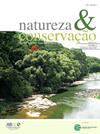Jaguar at the Edge: movement patterns in human-altered landscapes
IF 3.5
2区 环境科学与生态学
Q1 BIODIVERSITY CONSERVATION
引用次数: 0
Abstract
Human-caused habitat loss and fragmentation have significantly impacted the natural environments of large carnivores, altering their movement patterns and increasing risks such as hunting and road collisions. This study aims to understand the movement of jaguars (Panthera onca) through forests, agriculture of varying patch sizes, their distances to these structures, and roads and drainages. By analyzing movement speed, revisits, time spent inside these structures, and the timing of the last visit, data from 54 GPS-tagged jaguars in South America reveal a pronounced tendency to revisit the edges of these landscape variables. Additionally, jaguars showed a stronger affinity for natural areas, spending more time in large forest patches and reducing their speed in natural drainages. Areas with extensive agriculture had fewer revisits, and jaguars moved faster near roads. These results demonstrate the level of tolerance and the dangers this species faces in a landscape with anthropogenic aspects. This comprehensive assessment of movement patterns and landscape use provides valuable insights into how landscape structure influences habitat preference and mobility rates, which is crucial for future jaguar conservation and management strategies.

边缘的美洲虎:人类改变景观的运动模式
人类造成的栖息地丧失和破碎化严重影响了大型食肉动物的自然环境,改变了它们的活动模式,增加了狩猎和道路碰撞等风险。这项研究旨在了解美洲虎(Panthera onca)在森林、不同面积的农田、它们与这些建筑的距离、道路和排水系统中的运动。通过分析移动速度、重访次数、在这些结构中停留的时间以及最后一次访问的时间,来自南美洲54只带有gps标记的美洲虎的数据显示,它们有明显的倾向于重访这些景观变量的边缘。此外,美洲虎对自然区域表现出更强的亲和力,在大片森林中花费更多的时间,并降低了它们在自然排水中的速度。有大量农业的地区,美洲虎的回头率更低,而且在公路附近移动得更快。这些结果表明了该物种在具有人为因素的景观中所面临的容忍水平和危险。这种对活动模式和景观利用的综合评估为景观结构如何影响栖息地偏好和流动性提供了有价值的见解,这对未来美洲虎的保护和管理策略至关重要。
本文章由计算机程序翻译,如有差异,请以英文原文为准。
求助全文
约1分钟内获得全文
求助全文
来源期刊

Perspectives in Ecology and Conservation
Environmental Science-Nature and Landscape Conservation
CiteScore
7.80
自引率
4.30%
发文量
46
审稿时长
59 days
期刊介绍:
Perspectives in Ecology and Conservation (PECON) is a scientific journal devoted to improving theoretical and conceptual aspects of conservation science. It has the main purpose of communicating new research and advances to different actors of society, including researchers, conservationists, practitioners, and policymakers. Perspectives in Ecology and Conservation publishes original papers on biodiversity conservation and restoration, on the main drivers affecting native ecosystems, and on nature’s benefits to people and human wellbeing. This scope includes studies on biodiversity patterns, the effects of habitat loss, fragmentation, biological invasion and climate change on biodiversity, conservation genetics, spatial conservation planning, ecosystem management, ecosystem services, sustainability and resilience of socio-ecological systems, conservation policy, among others.
 求助内容:
求助内容: 应助结果提醒方式:
应助结果提醒方式:


